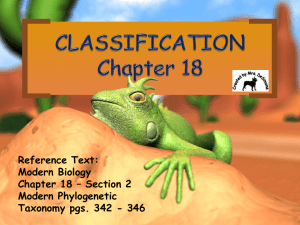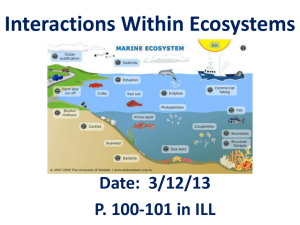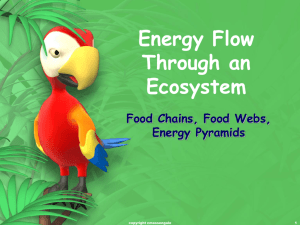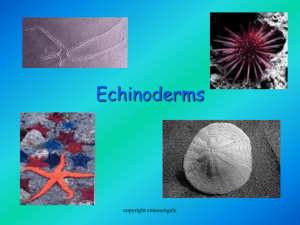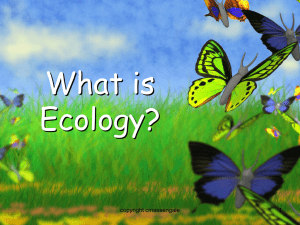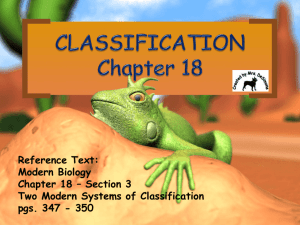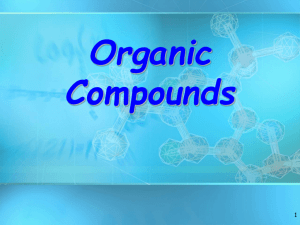Standard 5 Review PPT
advertisement
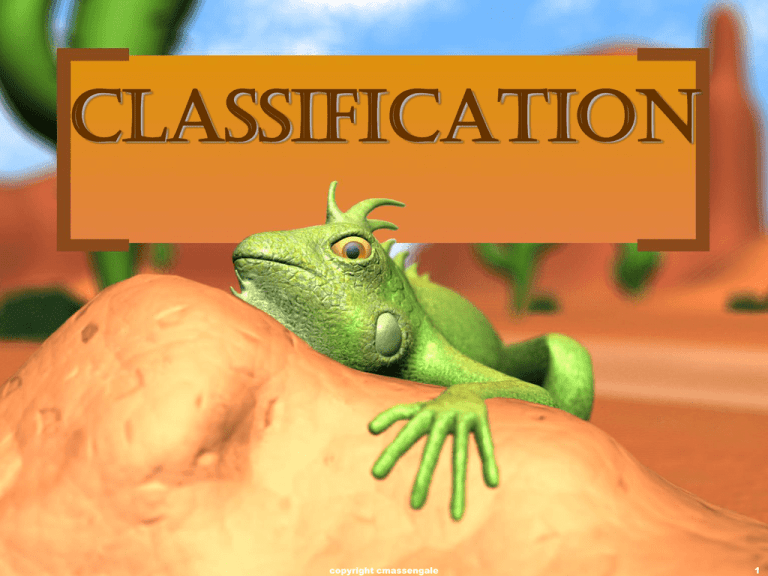
CLASSIFICATION copyright cmassengale 1 Species of Organisms • There are 8.7 million known species of organisms • This is only 5% of all organisms that ever lived!!!!! • New organisms are still being found and identified copyright cmassengale 2 What is Classification? • • • Classification is the arrangement of organisms into orderly groups based on their similarities (TRAITS) Classification is also known as taxonomy Taxonomists are scientists that identify & name organisms copyright cmassengale 3 Early Taxonomists • 2000 years ago, • • Aristotle was the first taxonomist Aristotle divided organisms into plants & animals He classified animals by the way they move… Land, sea or air. copyright cmassengale 4 Early Taxonomists • Can you think of any problems with this classification scheme? copyright cmassengale 5 Early Taxonomists • • John Ray, a botanist, was the first to use Latin for naming His names were very long descriptions telling EVERYTHING about the plant (too long) copyright cmassengale 6 Carolus Linnaeus 1707 – 1778 • 18th century • • taxonomist Classified organisms by their structure Developed naming system still used today copyright cmassengale 7 Carolus Linnaeus • Called the “Father of Taxonomy” • Developed the modern system of • naming known as binomial nomenclature Two-word name (Genus & species) copyright cmassengale 8 Standardized Naming • RULES: Turdus migratorius • Binomial nomenclature • • • • Genus species Latin or Greek Capitalize genus, but NOT species Italicized in print Underline when writing copyright cmassengale American Robin 9 Binomial Nomenclature Which TWO are more closely related? copyright cmassengale 10 Rules for Naming Organisms • The International Code for Binomial • • Nomenclature contains the rules for naming organisms All names must be approved by International Naming Congresses (International Zoological Congress) This prevents duplicated names copyright cmassengale 11 Classification Groups • Taxon ( taxa-plural) is a category into • • which related organisms are placed There is a hierarchy of groups (taxa) from broadest to most specific Kingdom, Phylum, Class, Order, Family, Genus, species copyright cmassengale 12 Hierarchy-Taxonomic Groups BROADEST TAXON Domain Kingdom Phylum (Division – used for plants) Class Order Family Genus Most Species Specific copyright cmassengale 13 King Phillip Can Order Family Game Saturdays! copyright cmassengale 14 copyright cmassengale 15 Kingdoms and Classification If you had 10 minutes to buy milk and chips in a new grocery store, would you know where to look? If the store has things classified, it makes it easier and faster to locate items Classification is Everywhere • Grocery stores classify items by type: • • baking items, dairy items, frozen food, Post offices classify mail by destination: zip code, then street, then house number Schools classify students by traits: grade number, gender, academic ability Benefits of Classifying • Accurately & uniformly names • • organisms Prevents misnomers such as starfish & jellyfish that aren't really fish Uses same language (Latin or some Greek) for all names Sea”horse”?? copyright cmassengale 19 Devil Cat Ghost Cat Mountain Lion Screaming Cat Puma Florida Panther Cougar • • • There are at least 50 common names for the animal shown on the previous 7 slides. Common names vary according to region. Soooo……why use a scientific name? Confusion in Using Different Languages for Names copyright cmassengale 28 Latin Names are Understood by all Taxonomists copyright cmassengale 29 Felis concolor Latin Names are Understood by all Taxonomists • Using scientific names helps scientists communicate better and reduces confusion. copyright cmassengale 31 Benefits of Classifying • Classification helps provide a better understanding of the relationships among living things. copyright cmassengale 32 Classification gives clues • Scientists have identified more than 8 • • • million species of organisms on Earth Scientists group organisms based on similarities When organisms are arranged in groups, they are easier to study Classifying organisms into groups is called Taxonomy What is a cassowary? • What does a cassowary look like? • What does a cassowary eat? • How big is a cassowary? If you know that a cassowary is classified as a bird, you also know that… • • • • • • • It has wings It has feathers It has hollow bones It has a beak It is probably an omnivore It can be seen using only the eyes Classification clues us in The History of Classification copyright cmassengale 36 Scientists classify based on STRUCTURE • The basic structure of an organism doesn’t change. • What would happen if we classified organisms based on color? • A zebra and a zebra fish would be cousins! Aristotle had two kingdoms Plants • Don’t Move • Green Animals • Move around After Careful observation… • Fungi didn’t fit… • Can grow in the dark • Spring up overnight • Need dead things to • grow on So a 3rd kingdom was created for Fungi A sampling of fungi Mold Yeast More examples of fungi Truffles Mushrooms This 3-kingdom system lasted for several hundred years • Until microscope technology allowed us to see smaller organisms Most of what they saw in the microscope wouldn't fit into these three kingdoms • • Paramecium They could move like animals, but had only one cell They didn’t have to “mate” to reproduce So scientists created a fourth kingdom called Protista • Single celled • Live in water or very • • • moist environments Most can move Some are photosynthetic Many are parasites A sampling of protists Euglena Giardia More protists algae amoeba These 4 kingdoms were the only ones for a few years until microscopes improved, and we could see inside single cells • • We noticed differences in nuclei Some organisms didn’t have a nucleus at all – only a single chromosome floating in the cytoplasm • Initially all these small prokaryotic cells • were grouped into Kingdom MONERA. Later, as we made more observations, another difference appeared. There are now two groups of bacteria, based on the composition of their cell walls. copyright cmassengale 48 ARCHAEABACTERIA • Probably the 1st cells to evolve • Live in HARSH environments • Found in: – Sewage Treatment Plants – Thermal or Volcanic Vents – Hot Springs or Geysers that are acid – Very salty water (Dead Sea; Great Salt Lake) copyright cmassengale 49 ARCHAEAN copyright cmassengale 50 EUBACTERIA • Some may cause DISEASE • Found in ALL HABITATS except • • harsh ones Important decomposers for environment Commercially important in making cottage cheese, yogurt, buttermilk, etc. copyright cmassengale 51 Live in the intestines of animals copyright cmassengale 52 A sampling of Monerans Strep bacteria Staph bacteria More Monerans E. coli bacteria Meningiococcal bacteria Even more Monerans Sleeping sickness pneumonia Currently there are 6 kingdoms Animalia Plantae Fungi Protista Archaebacteria Eubacteria copyright cmassengale 58 Number of organisms Some scientists even want to create a 7th kingdom for viruses Viruses aren’t technically alive because they can’t live without a host A sampling of viruses ebola influenza More Viruses cold H.I.V. The better our technology becomes, the more we know about organisms We have a system for describing exactly where things fit…..TAXONOMY Just like when you send a letter to Portugal, first you specify the country, then the city, then the street, then the building, then the floor number, then left or right, then the room number. Otherwise it would be impossible to find people. So how do we know where to put things in the classification scheme? Remember, living things are classified on similarities in structure. First, start with the kingdom A Snowy Owl belongs to the animal kingdom because • it can move • it is made of more than one cell • it has to eat Then, decide on the Phylum A Snowy Owl belongs to the Chordata Phylum because • It has a spinal cord • It has bones Then, decide on the Class A Snowy Owl belongs to class Aves because • It has a feathers • It has a beak • It lays eggs Then decide on the Order A Snowy Owl belongs to the order Strigiformes because • It is a carnivore • It has large, sharp talons Then decide on the Family A snowy owl belongs to the family Stringidae because • It has a hooked beak • It has a round face • It hunts at night Then decide on the genus, A Snowy Owl belongs to the genus Bubo because • It lives in the Northern Hemisphere • It has a fourth talon Then decide on the species A Snowy Owl belongs to the scandiacus species because • It is white • It weighs about 40 grams • It has dense downy feathers The more classification levels that are shared by two organisms, the more alike they are. A snowy owl is more like a barn owl than an sparrow. If they are in the same species, they can breed and produce offspring that can also reproduce. Scientific name = Genus species Example: Homo sapiens = humans Which of these are most closely related? A Felis familiaris B Canis familiaris C Canis lupus Which of these are most closely related? Eukaryotic Kingdoms • Protista (protozoans, algae…) • Fungi (mushrooms, yeasts …) • Plantae (multicellular plants) • Animalia (multicellular animals) copyright cmassengale 78 Protista • Most are unicellular • Some are • • multicellular Some are autotrophic, while others are heterotrophic Aquatic copyright cmassengale 79 Fungi • Multicellular, except • • yeast Absorptive heterotrophs (digest food outside their body and then absorb it) Cell walls made of chitin copyright cmassengale 80 Plantae •Multicellular •Autotrophic •Absorb sunlight to make glucose – Photosynthesis •Cell walls made of cellulose copyright cmassengale 81 Animalia • Multicellular • Ingestive • heterotrophs (consume food and digest it inside their bodies) Feed on plants or animals copyright cmassengale 82 copyright cmassengale 83 Taxons • • • Most genera contain a number of similar species The genus Homo is an exception (only contains modern humans) Classification is based on evolutionary relationships copyright cmassengale 84 Basis for Modern Taxonomy • • • Homologous structures (same structure, different function) Similar embryo development Molecular Similarity in DNA, RNA, or amino acid sequence of Proteins copyright cmassengale 85 xxx • xxx copyright cmassengale 86 Dichotomous Key • Used to identify organisms • Characteristics given in pairs • Read both characteristics and either go to another set of characteristics OR identify the organism copyright cmassengale 87 Example of Dichotomous Key 1a Tentacles present – Go to 2 1b Tentacles absent – Go to 3 2a Eight Tentacles – Octopus 2b More than 8 tentacles – Go to 3 3a Tentacles hang down – Go to 4 3b Tentacles upright–Sea Anemone 4a Balloon-shaped body–Jellyfish 4b Body NOT balloon-shaped – Go to 5 copyright cmassengale 88 the enD………. copyright cmassengale or is it? 89
